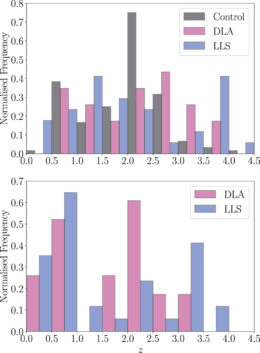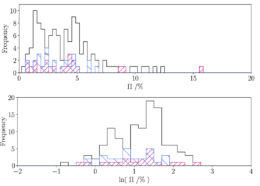How do magnetic fields form and evolve in early galaxies? A new study has provided some clever observations to help us answer this question.
The Puzzle of Growing Fields
Dynamo theory is the primary model describing how magnetic fields develop in galaxies. In this picture, magnetic fields start out as weak seed fields that are small and unordered. These fields then become ordered and amplified by large-scale rotation and turbulence in galaxy disks and halos, eventually leading to the magnetic fields we observe in galaxies today.

Schematic showing how to indirectly measure protogalactic magnetic fields. The measured polarization of a background quasar is altered by the fields in a foreground protogalaxy. Click for a closer look! [Farnes et al. 2017/Adolf Schaller/STSCI/NRAO/AUI/NSF]
The key is to find early protogalaxies that absorb the light of more distant background objects. If a protogalaxy lies between us and a distant quasar, then magnetic fields of the protogalaxy — if present — will affect the polarization measurements of the background quasar.
Observing Galactic Building Blocks

Top: Redshift distribution for the background quasars in the authors’ sample. Bottom: Redshift distribution for the foreground protogalaxies the authors are exploring. [Farnes et al. 2017]
Farnes and collaborators were unable to detect either coherent or random magnetic fields in DLAs. LLSs, however, showed some evidence of coherent magnetic fields and significant evidence of incoherent magnetic fields. The observations show that the magnetized gas in LLSs must be highly turbulent on a scale of ~5–20 parsecs — similar to turbulence scales in the Milky Way.
Support for Dynamos
What do these observations imply? Both support the dynamo theory of magnetic field growth in galaxies!

Polarization fraction distributions (top) and their logarithms (bottom) for sources with and without protogalaxies in the foreground (pink for DLAs, blue for LLSs, and grey for no intervenor). Statistical analysis reveals that the distribution for LLSs differs from the control sample, indicating the presence of magnetized gas. [Adapted from Farnes et al. 2017]
Farnes and collaborators’ data indicate that magnetic fields are indeed being gradually built up in early galaxies by dynamos. They also suggest that DLAs may represent an earlier galactic evolutionary stage than LLSs, as DLAs haven’t yet had the time to develop their magnetic fields to a detectable level.
A future increase in sample size will certainly help improve our understanding of the field formation process. In the meantime, the data in this study provide the first observational picture of magnetic field evolution in galaxies, lending excellent support to theoretical models.
Citation
J. S. Farnes et al 2017 ApJ 841 67. doi:10.3847/1538-4357/aa7060


2 Comments
Pingback: Probing Magnetic Fields of Early Galaxies – MeasurementDataBases for Industry & Science
Pingback: magnetic fields in early galaxies